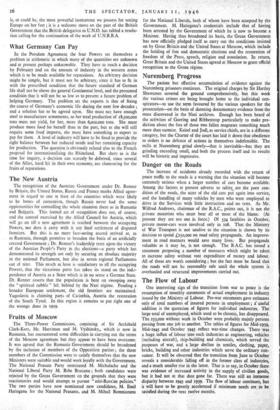The Flow of Labour
One interesting sign of the transition from wax to peace is the resumption of monthly statements of actual employment in industry issued by the Ministry of Labour. Pre-war statements gave estimates only of total numbers of insured persons in employment ; d useful addition is the quotation of figures for individual industries. The large total of unemployed, which used to be chronic, has disappeared. The 253,000 without work in October were probably mainly persons passing from one job to another. The tables of figures for Mid-1939, Mid-1945 and October 1945 reflect war-time changes. There was a huge influx of labour into such industries as engineering, vehicles (including aircraft), ship-building and chemicals, which served the purposes of war, and a large decline in textiles, clothing, paper, bricks, building and other industries which serve the ordinary con- sumer. It will be observed that the transition from June to October reveals a considerable falling off in the former class of industries, and a much smaller rise in the latter. That is to say, in October there was evidence of increased activity in the supply of civilian goods, but it had not at that date gone far. There was still an immense disparity between 1945 and 1939. The flow of labour continues, but it will have to be greatly accelerated if minimum needs are to be satisfied during the next twelve months.






























 Previous page
Previous page